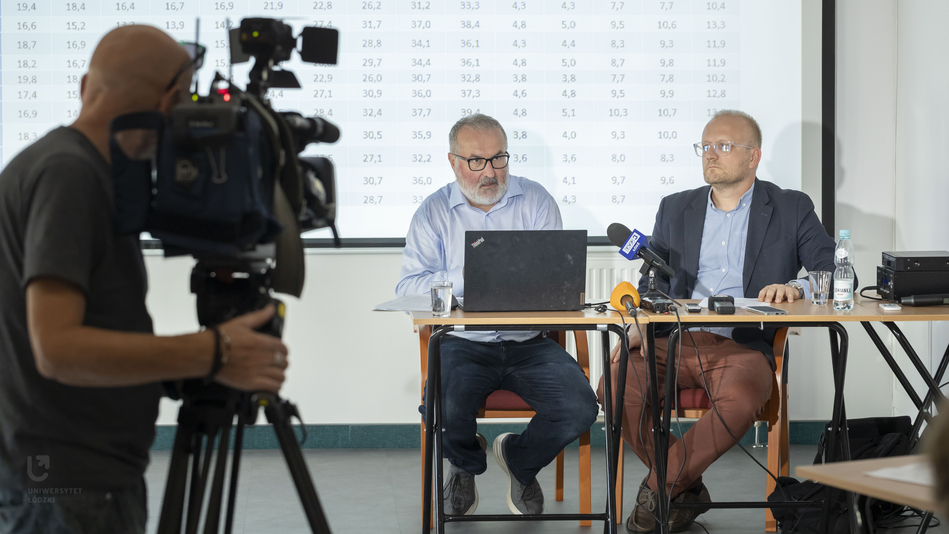 Prof. Piotr Szukalski and Dr Marcin Gońda (on the right) are telling the journalists about the demographic future of the Lodz Voivodeship
Prof. Piotr Szukalski and Dr Marcin Gońda (on the right) are telling the journalists about the demographic future of the Lodz Voivodeship
Inevitable depopulation of Lodz and the voivodeship
The scientists presented their analyses based on the latest "Prognoza demograficzna Głównego Urzędu Statystycznego do roku 2060" [Demographic projection of the Statistics Poland until 2060], which was published on 31 August this year. They focused on population data and their changes in the coming decades regarding the Lodz Voivodeship, its largest cities (Lodz, Piotrków, Skierniewice) and all counties of the region.
The projection presented by the University of Lodz demographers are not optimistic. The Lodz Voivodeship, together with the Świętokrzyskie, Opole, Lublin and Warmian-Masurian Voivodeships, will be among those that are most affected by depopulation. Its population will decrease from almost 2.4 million today to just over 2.1 million in 2040 and to less than 1.8 million in 2060, which means a decrease by one quarter compared to the starting year, i.e. 2022.
In general, the areas surrounding the largest cities in the region, especially Lodz, will be in the best situation. This is due to the assumption by Statistics Poland forecasters that suburbanisation will also occur in the coming decades, i.e. the settlement of wealthier residents who want to combine work and consumption in the city with living in quasi-rural areas in the suburbs of cities, which ensure a higher quality of recreation. Nevertheless, even in the case of suburban areas of Lodz, Piotrków Trybunalski and Skierniewice, a decline in the number of inhabitants can be seen, although at a much slower pace
– writes Dr hab. Piotr Szukalski, Associate Professor in his report.
The worst situation is to occur in two types of areas and towns: on the one hand, on the outskirts of the voivodeship, far from the capital of the region, neighbouring with the peripheral areas of other voivodeships, where the population is expected to decline by up to 30% by 2060 (Łęczyca, Opoczyński, Pajęczno, Radomsko, Wieluń counties). On the other hand – in the cities with county rights (Lodz, Skierniewice, Piotrków Tryb.), where the expected population decline is equal to that in the peripheries or even greater, such as in Piotrków Trybunalski.
In the long term, the population situation of the voivodeship and its capital, as well as the entire country, could be improved either by a marked increase in the readiness to have children or by consent to mass immigration to Poland
– concludes Prof. Szukalski.
 The scientists presented demographic trends for all counties of the voivodeship (a table in the background). Dr Gońda reported to what extent Ukrainian immigration could eliminate negative population trends in the voivodeship.
The scientists presented demographic trends for all counties of the voivodeship (a table in the background). Dr Gońda reported to what extent Ukrainian immigration could eliminate negative population trends in the voivodeship.
Will Ukrainian immigration slow down the decline in the number of inhabitants of the region of Lodz?
How will Ukrainian immigration affect these negative demographic trends in Lodz and the voivodeship? Do many Ukrainians who took refuge in the region from Russian aggression think about staying permanently in their current place of residence?
Data regarding applications for granting PESEL UKR number in connection with the war in Ukraine shows that from the moment they were assigned to Ukrainian citizens, i.e. from 16 March to 28 November 2022, approximately 61,000 of them were issued in the Lodz province. Data from the Lodz Voivodeship Office, which concerns tasks carried out in the voivodeship financed or co-financed from the Ukraine Assistance Fund, show that in November 2022, there were 77.4 thousand war refugees in the voivodeship, of which 28.6 thousand were in Lodz.
According to some estimates, up to 25% Ukrainians want to stay in the voivodeship permanently. (average for representatives of economic and war immigration). However, all simulations show that immigration from Ukraine may, to some extent, contribute to improving the demographic situation of the Lodz Voivodeship and its capital.
It should not be expected though that it will put an end to all the problems of the depopulating region, but it will allow time to prepare other solutions (e.g. increasing the fertility rate, developing the so-called silver economy) to counteract the negative consequences of the demographic collapse. However, the authorities' actions should be aimed at encouraging immigrants who have already arrived in Poland to stay here
– underlines Dr Marcin Gońda.
Source: Piotr Szukalski, Marcin Gońda, Faculty of Economics and Sociology, University of Lodz
Edit: Communications and PR Centre, University of Lodz
Photos: Maciej Andrzejewski (Communications and PR Centre, University of Lodz)
